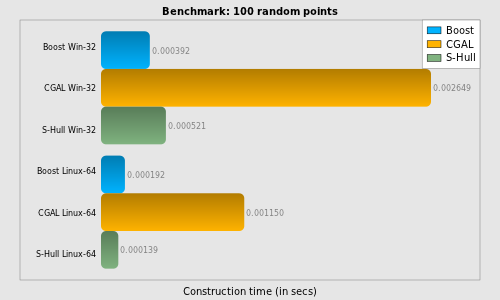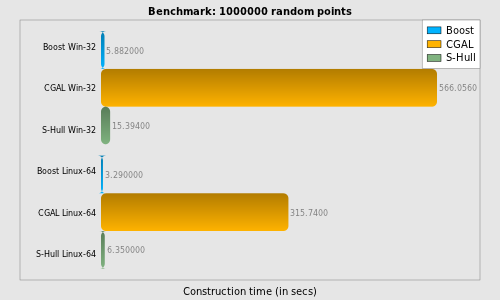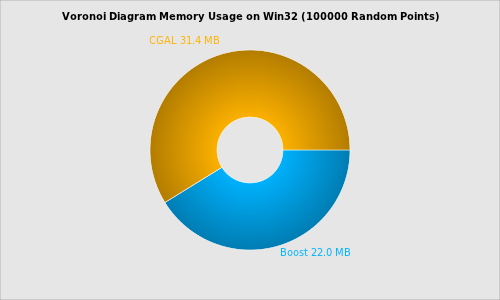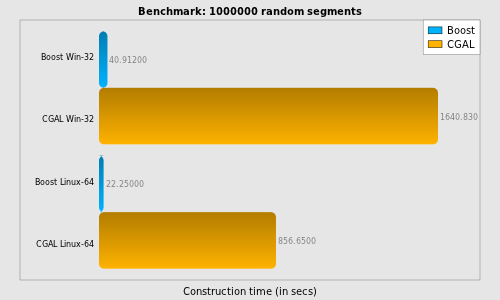Contents
- Boost.Polygon Main Page
- Design Overview
- Isotropy
- Coordinate Concept
- Interval Concept
- Point Concept
- Segment Concept
- Rectangle Concept
- Polygon 90 Concept
- Polygon 90 With Holes Concept
- Polygon 45 Concept
- Polygon 45 With Holes Concept
- Polygon Concept
- Polygon With Holes Concept
- Polygon 90 Set Concept
- Polygon 45 Set Concept
- Polygon Set Concept
- Connectivity Extraction 90
- Connectivity Extraction 45
- Connectivity Extraction
- Property Merge 90
- Property Merge 45
- Property Merge
- Voronoi Main Page
- Voronoi Benchmark
- Voronoi Builder
- Voronoi Diagram
- Voronoi Predicates
- Voronoi Robust FPT
Other Resources
Polygon Sponsor
Voronoi Benchmark
There are not many known Voronoi libraries that are capable to satisfy the following set of conditions:- could handle input data sets of points and segments
- give exact warranties about the algorithm robustness and
output topology
- compute coordinates of the output geometries within the fixed relative precision
- Boost.Polygon Voronoi - satisfies all the conditions above, implements sweep-line algorithm.
- CGAL - satisfies the first two conditions, implements incremental algorithm. CGAL is a well-known
library in the computational geometry area, especially for its
robustness.
- S-Hull
- doesn't satisfy any of the above conditions. S-Hull is a non-robust
implementation of the sweep-hull algorithm used to construct Delaunay
triangulation of a set of points.
Other libraries (OpenVoronoi, Triangle) would be added to this benchmark incrementally (we are open for suggestions).
Important
While results of this benchmark show complete dominance of
the Boost.Polygon Voronoi over the CGAL Delaunay Graph implementation,
we would like to make it clear
that both libraries use different approach to construct Voronoi
diagram. Thus there are problems where the CGAL's incremental approach would
be still more vital than the sweep-line algorithm (e.g. input sites are
inserted as a live stream
data).Voronoi Benchmark Details
The benchmark consists of the two parts:- The first one constructs the Voronoi diagram of a set of random points (voronoi_benchmark_points.cpp)
- The second one constructs the Voronoi diagram of a set of random segments (voronoi_benchmark_segments.cpp)
- We ensure that input data sets are the same for all libraries by initializing random generator with the same seed
- We ensure that input data sets that consist of segments don't contain intersections using Boost.Polygon functionality
- S-Hull's implementation doesn't process duplicate points
properly, thus those are eliminated before the algorithm execution
explicitly (Boost.Polygon Voronoi and CGAL do that implicitly)
- There is no Voronoi diagram data structure in CGAL/S-Hull. That's why we use the segment Delaunay graph which is topologically dual to the Voronoi diagram
- CGAL's and S-Hull's output Delaunay triangulation doesn't contain information
about coordinates of the Voronoi vertices. We didn't include time to compute Voronoi vertices and memory
storage required for those in this benchmark.
- Both Boost.Polygon Voronoi and CGAL process each input segment as 3 input objects (segment itself and its endpoints), thus the running time and memory usage for Voronoi of segments would be at least 3 times slower than for Voronoi of points
Hardware: Intel i5-7600 2.8 GHz, 4GiB RAM.
OS: Windows 7 Professional 32-bit.
Libraries: Boost 1.48.0, CGAL-4.0.
Hardware: Intel i5-7600 2.8 GHz, 4GiB RAM.
OS: Ubuntu 11.10 64-bit.
Libraries: Boost 1.48.0, CGAL-4.0, GMP 5.0.4, MPFR 3.1.0 + cumulative patch.
Voronoi Benchmark Results
Random Points Benchmark
| Test specification |
Average construction
time (in secs) |
||||||
| Number
of Points |
Number
of Runs |
Boost
Win-32 |
CGAL
Win-32 |
S-Hull Win-32 |
Boost
Linux-64 |
CGAL
Linux-64 | S-Hull Linux-64 |
| 10 |
100000 |
0.000027 |
0.000116 |
0.000043 |
0.000013 |
0.000052 | 0.000012 |
| 100 |
10000 |
0.000392 |
0.002649 |
0.000521 |
0.000192 |
0.001150 | 0.000139 |
| 1000 |
1000 |
0.004541 |
0.039140 |
0.007125 |
0.002130 |
0.016680 | 0.002010 |
| 10000 |
100 |
0.047540 |
0.684090 |
0.091640 |
0.022900 |
0.297900 | 0.028300 |
| 100000 |
10 |
0.530200 |
16.904600 |
1.218000 |
0.274000 |
8.047000 | 0.432000 |
| 1000000 |
1 |
5.882000 |
566.056000 |
15.394000 |
3.290000 |
315.740000 | 6.350000 |
 |
 |
 |
 |
 |
 |
 |
 |
Random Segments Benchmark
| Test specification |
Average construction time (in secs) | ||||
| Number
of Segments |
Number
of Runs |
Boost
Win-32 |
CGAL
Win-32 |
Boost
Linux-64 |
CGAL
Linux-64 |
| 10 |
100000 |
0.000290 |
0.001047 |
0.000165 |
0.000483 |
| 100 |
10000 |
0.003655 |
0.014812 |
0.002006 |
0.007006 |
| 1000 |
1000 |
0.038158 |
0.177315 |
0.020440 |
0.084000 |
| 10000 |
100 |
0.389470 |
2.561340 |
0.209700 |
1.191900 |
| 100000 |
10 |
4.031300 |
49.314600 |
2.228000 |
23.538000 |
| 1000000 |
1 |
40.912000 |
1640.830000 |
22.250000 |
856.650000 |
 |
 |
 |
 |
 |
 |
 |
 |
Voronoi Benchmark Summary
The main conclusions for the benchmark results above are following:- There is no input size range were CGAL would outperform Boost.Polygon Voronoi. Even considering the fact that we didn't include time it would take CGAL to compute coordinates of the Voronoi vertices.
- The more interesting fact is that robust implementation of
the Boost.Polygon Voronoi is faster than non-robust of
S-Hull (except small input sets of around 100 points on Linux-64).
- Logarithmic execution time shows that Boost.Polygon Voronoi and S-Hull
have clear N*log(N) complexity, while this doesn't seem to be true for
CGAL (at least for large input data sets).
- Boost.Polygon Voronoi computes coordinates of the output
Voronoi vertices within 64 machine epsilon precision. There are no such
warranties for the CGAL library.
- Boost.Polygon Voronoi of points is 4 times faster for small input data sets (10 points) and this factor grows up to 100 for large input data sets (1000000 points).
- Boost.Polygon Voronoi of segments is 3 times faster for small input data sets (10 segments) and this factor grows up to 40 for large input data sets (1000000 segments).
- Boost.Polygon Voronoi is capable to construct Voronoi of 10000 points or 1000 segments in 0.02 seconds. This allows to produce real time frame rate for those quantities.
| Copyright: | Copyright © Andrii Sydorchuk 2010-2012. |
|---|---|
| License: | Distributed under the Boost Software License, Version 1.0. (See accompanying file LICENSE_1_0.txt or copy at http://www.boost.org/LICENSE_1_0.txt) |

